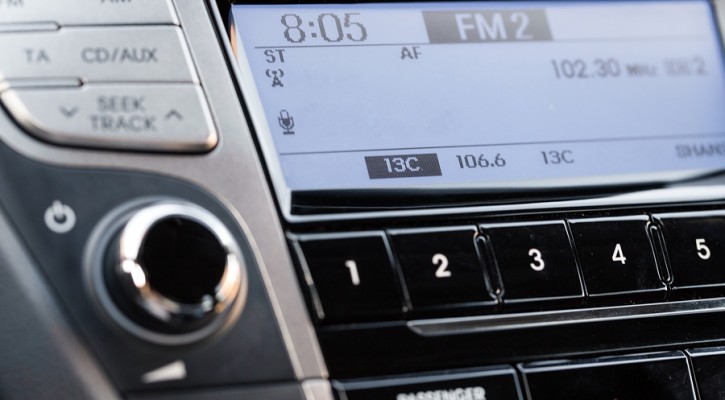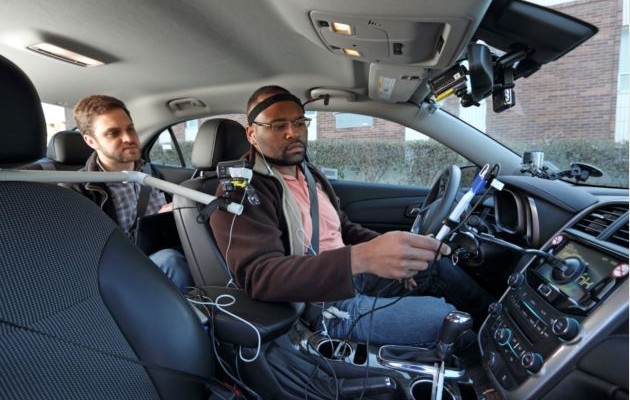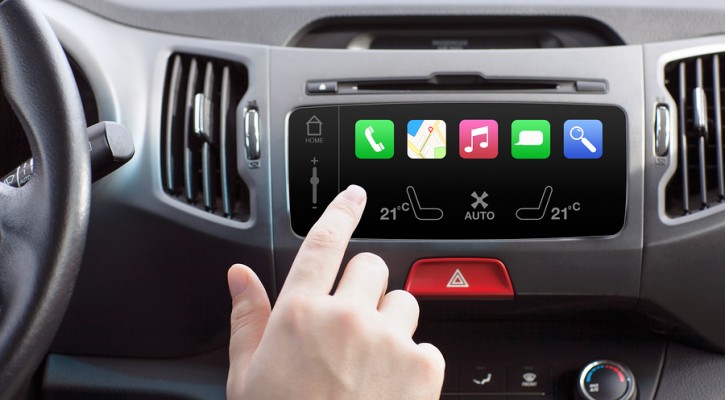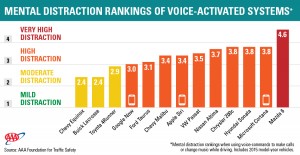Tag Archive: Distracted driving

Is The Car Radio Distracting?
May 2, 2016
In still more research on distracted driving, researchers in the United Kingdom looked at whether or not the car radio could be distracting to drivers. The researchers from University College Dublin, Ireland conducted a small scale study using 36 drivers in a full size driving simulator to test whether or not the car radio interfered with a driver’s attention enough to pose a danger. The data seems to support past research that has been conducted on the use of cell phones while driving.
The study was designed to test what’s known as the “perceptual load theory of attention.” That theory states that people only have a limited amount of attention to work with and, once they reach their limit, they can’t process any more information. In this case, the researchers wanted to see if information overload by one sense (hearing) could affect another sense (sight).
The subjects were divided into two groups; a “low attention load” and a “high attention load.” Those in the low attention load group were told to listen to the traffic report on the radio and to note when the traffic reporters switched from male to female, a task that didn’t require a lot of attention.
Those in the high attention load group were told to listen for traffic reports regarding a specific highway; a task that required a good deal more attention. While both groups drove over the simulated course, the researchers would randomly place a large gorilla or an elephant at the side of the road.
The researchers found that 71 percent of those in the low attention load group noticed the gorilla or elephant. In the high attention load group, only 23 percent noticed the large, misplaced animals on the side of the road. The high attention load group also had greater difficulty in obeying yield signs and maintaining proper speed and lane position to avoid hazards.
The fact that the high attention load group experienced difficulty while listening to the radio for comprehension parallels the results of a study conducted by Carnegie Melon researchers in 2008. In that study, subjects were tested first while driving over a simulated driving course and then, when driving over a similar course while carrying on a simulated cell phone conversation; all while their brains were being scanned by an MRI. The study was designed to show what areas of the brain showed the most activity while performing a task. In the first test, without the use of a cell phone, the area of the brain that controlled for spacial awareness (where your body is in relation to other objects around it) was the most active. In the second part of the study where subjects drove while carrying on a simulated cell phone conversation, the area of the brain that showed the most activity was the area that controlled language comprehension and the activity in the spacial awareness area was reduced by 37 percent.
That convinced the Carnegie Melon researchers that “multi-tasking” is a myth; the brain isn’t capable of handling two or more tasks equally at the same time. To concentrate on one task the brain has to rob attention from another control center.
For most drivers, listening to the car radio is a very low attention load activity. For most, listening to the car radio is just background noise. If the average driver were asked what song just played or what product was just advertised, he or she would be unable to say. Usually, the car radio isn’t a distraction at all but, when listening for comprehension, the brain has to shift processing power away from paying attention to the road to paying attention to the radio. If you’ve ever turned down or turned off the car radio while looking for an address or navigating through a strange city, you’re probably instinctively aware of this fact. Paying attention to a cell phone conversation instead of the road ahead is the same thing.
For more information, visit: Does listening to the radio make driving more dangerous?

Hands Free Distracts Drivers Long After Hanging Up
November 6, 2015
We’ve written before on the fact that hands free communication devices are no safer or any less distracting for drivers than hand held devices; now there’s evidence that shows they’re still distracting, even after hanging up.
A new study conducted by the University of Utah for the AAA Foundation for Traffic Safety (AAA) shows that it can take up to 27 seconds before the brain can refocus on the task of driving after hanging up on a hands free call or text message. To put that into context, over a period of 27 seconds, a vehicle traveling at just 25 mph will cover approximately 992 feet or the length of three football fields before the driver is able to fully concentrate on the mental task of driving.
The University of Utah conducted two different studies for AAA. The first studied the distraction level of using hands free voice commands to dial phone numbers, call contacts, select music, and send voice texts with Microsoft Cortana, Apple Siri and Google Now. The study showed that, while Google Now was a bit less distracting, all three systems were highly distracting to the drivers.
The second study looked at voice dialing, contact calling, and music selection using in-vehicle “infotainment” systems installed in ten different 2015 model year cars. The study found that three of the systems were moderately distracting, six were rated as highly distracting, and the system installed in the Mazda 6 was found to be very highly distracting.
The tests were conducted using volunteers ranging in age from 21 to 70. The volunteers were accompanied by a researcher as they drove at 25 mph on a 2.7 mile route in a Salt Lake City neighborhood. Each volunteer wore a head mounted device that flashed a red LED light every three to five seconds just to the left of the driver’s vision. Each time they saw the light, drivers would note it using a thumb mounted button. Cameras and other sensors mounted in the vehicle recorded how much time the driver’s eyes were on the road, mirrors, or dashboard. Drivers also participated in a survey to record their perceived attention span during and after the hands free activities. Before conducting the tests, the drivers were allowed to take the car home for a five day period to learn and try to become proficient with the systems.
Most people felt that their full attention was restored after hanging up but the data showed that wasn’t the case. The researchers feel that high tech manufacturers are rolling out the systems too early. There hasn’t been enough time devoted to perfecting the systems and verifying their safety.
Read more: Up to 27 seconds of inattention after talking to your car or smartphone
Photo and graph credits: AAA Foundation for Highway Safety

Careless Driving – Not Design – Responsible For Bridge Crashes
August 3, 2015
After several horrible crashes on Jacksonville Florida’s Buckman bridge, the Florida DOT conducted a study that found that careless driving and speed were responsible for crashes on the bridge, not the bridge design.
The call for the study came after two crashes in the past year made people question the safety of the large span across the St. John’s River. In the first crash, a small truck was sent over the guardrail and into the river. A Navy and police diver search located the driver’s body several hours later. In another crash in March of this year, a disabled SUV was struck by a semi and burst into flames, killing a mother and her three children.
The pickup crash into the river was not the first time a vehicle had gone over the railing into the river and the latest crash caused local residents and officials to question whether the railings on the bridge were high enough. The Florida Department of Transportation (FDOT) was tasked with conducting the study.
In the study, released by FDOT last week, the researchers looked at the previous five year history of crashes, both on the bridge and stretches of I-295 approaching each end. The researchers concluded that the structure of the eight-lane, three mile long double span met all safety requirements and didn’t contribute to the crashes, either on or adjacent to the bridge.
Instead, the researchers blamed careless driving and high speeds for the crashes. In their study, the researchers monitored average speeds throughout the day. In spite of the posted 65 mph speed limit, the researchers said that drivers drive at an average of 72 mph on the bridge.
Careless driving and distracted drivers also play a big part in the crashes on the bridge. In the crash that sent the pickup truck into the river, police reported that a distracted driver swerved to avoid hitting the car ahead and clipped the pickup truck sending it spinning over the bridge railing.
In the crash involving the family, as a driver behind the stalled SUV slowed to a stop, it was hit from behind by the driver of a large truck. As the first vehicle spun out of the lane, the truck plowed ahead and hit the SUV sending it into the guardrail where it burst into flames.
We have written before that there is no such thing as a motor vehicle “accident.” Accidents are something we have no control over. Motor vehicle crashes are caused by drivers who make a fatal error, such as; speeding, driving under the influence, or not paying attention to the road ahead.
Speed causes problems because a speeding driver has very little time to react when encountering a problem in the road ahead. Speeding also increases the impact forces in a crash.
A bridge like the Buckman carries a tremendous amount of traffic and, along with speeding drivers, there are slow drivers (probably on a cell phone) and drivers weaving in and out of lanes. The bridge has a high hump in the middle to allow for boat traffic and, if there’s an obstruction or problem ahead, a speeding, distracted driver won’t realize it until it’s too late. If ever there was a time to ignore the distractions and concentrate on the road ahead, it’s on a bridge like this one.
Speeding and distracted drivers, along with all the other drivers are trapped within the confines of the bridge and, should a problem occur ahead, there’s no room to escape. Drivers need to maintain a safe following distance of at least two seconds and watch, not only at what’s directly in front, but also as far down the road as possible. When driving over the hump, drivers should anticipate the possibility of problems ahead and give themselves extra room to maneuver or stop.
The only recommendations made by the researchers were for greater enforcement of the speed limit and for electric signs ahead of the bridge to warn of crashes or stalled vehicles on the bridge.
Read more: FDOT releases findings on Buckman Bridge crashes
Photo credit: First Coast News

Computer Display Screens In Cars Add To Distractions
July 8, 2015
Computer display screens that automakers are adding to their new models are going to add to the distractions on the road according to experts. The screens, which are tablet size, are supposed to fulfill all the functions of a smartphone.
Both Google and Apple are making built-in computer display systems for cars and automakers seem to be rushing to get them installed and out to potential buyers. According to the automakers, it’s what the customer wants.
Google is producing an Android based system called Android Auto and Apple is producing an iOS operated system they’re calling Apple CarPlay. Both systems are designed to sync with and provide all of the features available in a smartphone including, email, twitter, streaming music and maps. Other apps are also available and more are sure to be added as time goes on.
The computer makers claim that the built-in display screens, some of which feature no-touch and voice activated controls are safer for drivers to use than trying to get all the same information while holding a phone. That may be true in some cases but only to a small degree.
Using these display screens will still require a driver to look away from the road ahead and look at the screen, even if only for a couple of seconds. At 45 mph, a car will travel 132 feet in two seconds and a lot can happen in that distance and time.
According to researchers, voice-activated systems aren’t that safe. Studies have shown that a voice activated system like Siri can cause even more distraction than a hand-held phone. Part of the distraction comes from the frustration of dealing with a voice-activated system that doesn’t understand what you want or displays the wrong information.
When it comes to voice activated texting, researchers in Texas found that, if a driver chose to visually verify the contents of a text, the voice activated systems offered no safety advantage over manual texting.
The problem comes in the skills and brain functions needed to drive. Those are:
- Visual – Keeping your eyes on the road ahead and watching for signals or potential hazards.
- Manual – The manual act of steering and operating the pedals.
- Cognitive – Using your mind to interpret what you are seeing and to make minor or major changes in steering, speed, or both depending on what’s happening on the roadway.
All three of these skills and functions must act together in order to drive safely. If one or more are involved in another activity, driving becomes much more dangerous:
- Whether using hand-held phones or built-in display screens, to make choices, your vision is focused on the display screen and not the road ahead.
- While formulating a response to a text message or carrying on a phone conversation, your cognitive abilities are tied up in the act of texting or listening to the other person and your ability to make rapid decisions regarding the traffic situation is diminished.
- When waving your hand over a display screen to look for or make a music selection, you’re using all three of the functions and skills that should be focused on the very important job of driving.
Many drivers will find, much to their regret, that these display screens don’t add any appreciable degree of safety and they may make the road much more dangerous.
Read more: Car dashboards that act like smart phones raise safety issues
Smartphone Users Go Beyond Texting To Web Surfing, Video Chats While Driving
May 20, 2015
Smartphone users admit to going beyond texting while driving to a wide variety of smartphone activities according to a new study by AT&T. While cellphone use and texting are still the most common activity that drivers engage in, the AT&T study revealed that 70 percent of drivers engage in other smartphone activities such as taking selfies and even video chatting.
According to the AT&T news website, smartphone activities people say they do while driving include:
- Text (61%)
- Email (33%)
- Surf the net (28%)
- Facebook (27%)
- Snap a selfie/photo (17%)
- Twitter (14%)
- Instagram (14%)
- Shoot a video (12%)
- Snapchat (11%)
- Video chat (10%)
Other unsettling findings include:
- 62% keep their smartphones within easy reach while driving.
- 30% of people who post to Twitter while driving do it “all the time.”
- 22% who access social networks while driving cite addiction as a reason.
- Of those who shoot videos behind the wheel, 27% think they can do it safely while driving.
While AT&T is one of the major cellphone and smartphone marketers in the US, they recognized the dangers of cellphone use and texting while driving years ago. To educate drivers on the dangers of these activities, they launched the “It Can Wait” program in 2010. Their videos present a powerful message on the dangers of texting while driving and the impact those decisions can have on the cellphone user and their family.
As a result of this study, AT&T says it will expand the It Can Wait program to go beyond texting and warn drivers about the dangers of engaging in other types of smartphone activities while driving.
Other studies show that drivers are starting to realize the dangers of texting but, in spite of that awareness, they still seem to think that they are more skilled in the practice and the dangers only apply to other, less skilled drivers. Now it seems that the very dangerous issue of driver distraction is moving beyond texting into even more dangerous distracting activities.

